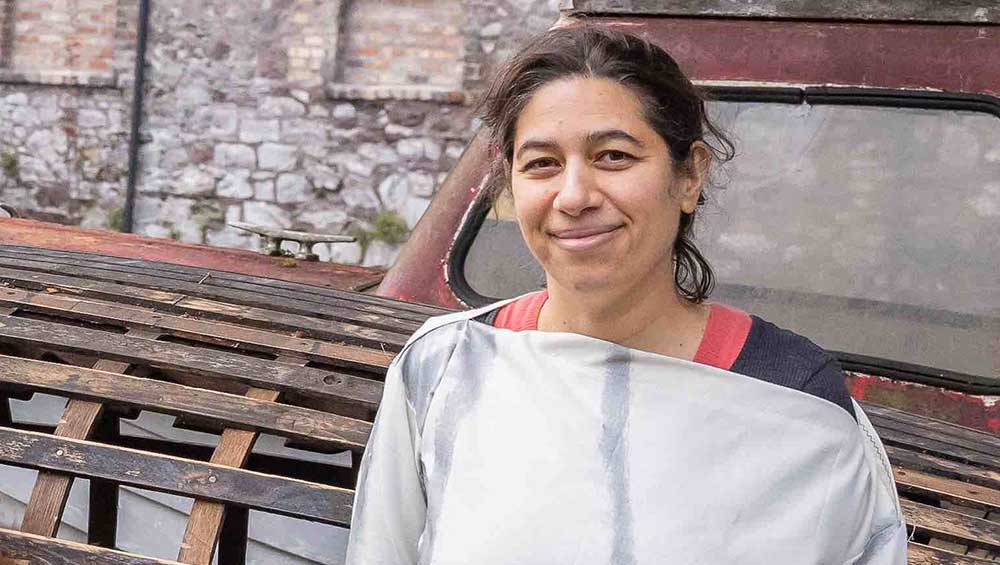
Ceyda Oskay. Photo courtesy John Beasley, Cork, 2022.
by JANET McKENZIE
In From the Margins is a wide-ranging project funded by the European Commission (Creative Europe) to give opportunity and support to artists who identify as asylum seekers or refugees. The project is hosted by five printmaking studios across Europe – in Amsterdam, Edinburgh, Ljubljana, Odense and Cork, through an artist-in-residence programme of one month each. There are six artists in each centre, making a total of 30 artists, who will exhibit in Edinburgh in April 2023. Studio International spoke to Ceyda Oskay, one of the artists in residence at Cork Printmakers in Ireland in November 2022.
Oskay is from Turkey and trained at the Royal College of Art (RCA) in London after a first degree in international studies (with research at the South African National Gallery in Cape Town) from the University of Chicago and an MA in Middle Eastern studies from the Middle East Technical University in Ankara. She spent more than 10 years doing humanitarian work with the UN in Syria, Turkey, Iraq, Kuwait, eastern Europe and Central Asia. She has also worked as a reporter and photojournalist for the Arab Times. She has exhibited widely internationally. Her multimedia work at Cork Printmakers for In From the Margins is a site specific and costumed musical collaboration. Oskay’s family was displaced when Saddam Hussein invaded Kuwait in 1990. Her work over many years for the UN, and her own experiences of displacement, have enabled her to dedicate much of her multimedia art practice to the urgent issues of displaced people and refugees. Having studied the public sphere pathway in contemporary art practice at the RCA, her work for In From the Margins seeks to focus on the experience of making and performance over product.
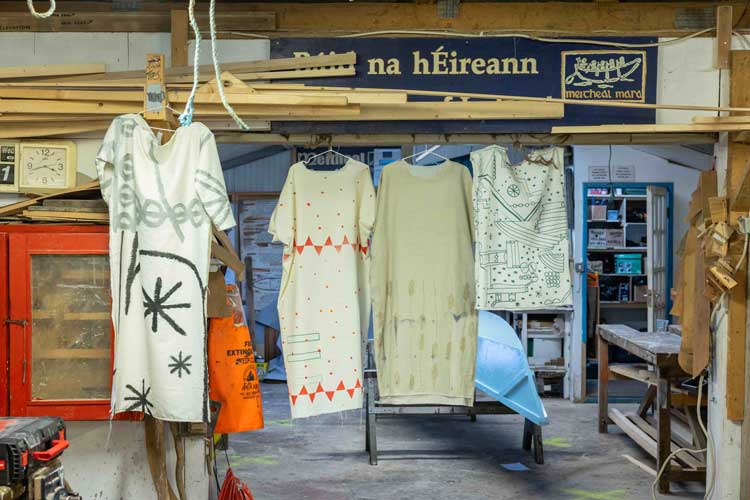
Garments from Ceyda Oskay’s clothing brand, cc by co, which she created for In From the Margins while an artist in residence at Cork Printmakers, hung in 2022 at Meitheal Mara Teoranta in Cork, the boatbuilding workshop that has employed former prisoners and others. The wheat depicted on the garment third from left is Red Stettin, which originated from the grain the Ottoman Empire sent to Ireland in 1847 during the Great Hunger. Photo courtesy John Beasley, Cork, 2022.
Since 2017, her practice has more formally woven together elements of clothes-making and fashion, alongside her fine art work and she has founded her clothing brand, cc by co (custom clothing by Ceyda Oskay). The clothing worn in the videos that she will show in Edinburgh includes material she drew with inspiration from migration in Ireland, printed and designed as clothing. Alongside a video of the collaborative performative work, the clothing itself, as part of her brand, is displayed and for sale. She works with clothing as it is related to migration itself, with textiles often being the few items that nomads, or those forcibly displaced, can carry with them. She also works with clothes as they relate to the body, and there is an element of healing in many of the clothing items.
Oskay’s interest in textiles began at a young age, with her mother and grandmother teaching her textile methods in Turkey. She spent part of her childhood in Saudi Arabia, one path on the Silk Road, and recalls going to markets with her mother and seeing fabrics from all over the world. She observes, too, the importance of textiles in world history, “from the trade in natural dyes and the social status of Tyrian purple for royalty, the trade in indigo and its transformative effect on farms in India, to textile weaving and the British industrial revolution”. The importance of fabrics to nomadic peoples and to migration makes their versatility and portability a perfect medium for her art practice.
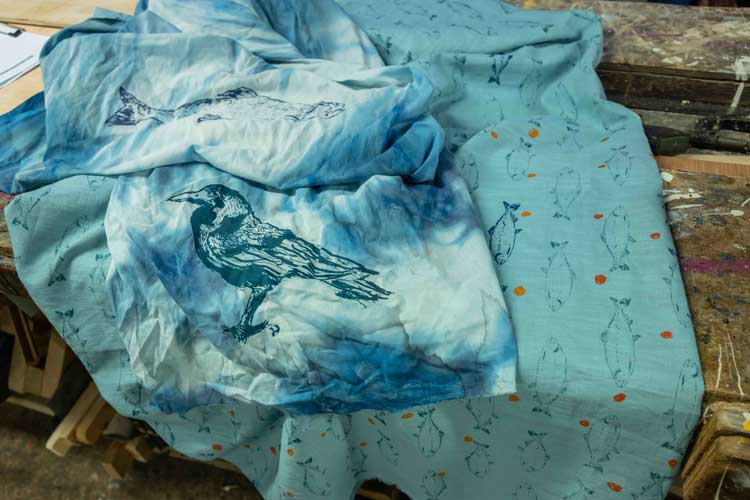
Handprinted garments by Ceyda Oskay, from In From the Margins, 2022, at Meitheal Mara Teoranta boatyard. Photo courtesy John Beasley, Cork, 2022.
Additionally, says, Oskay: “Textiles themselves are transformative – they can be changed into another item just by altering the way they are sewn and put together. They are easy to experiment with and I like experimentation in my work. I like the versatility and expression textiles offer, and their universality. I was interested in migration and war as memory – but, rather than preserving this memory in an object, I’m more interested in creating new and diverse experiences between people that transform them and create the hope of something better.”
In an artist’s statement for the Migration Museum in London in 2019, she wrote: “I mostly use textiles in my artwork (as conceptual craft), and work across a variety of themes including migration, gender, ethnography, sleep and conflict, sleep and ritual, and various aspects of war, drawing on my background in humanitarian work. I often dislocate and repackage, reworking and unravelling things in new locations, with an attempt at creating a common understanding and empathy between people. I reassemble. I have also worked in clay, plaster, print, photography, video and sound media, and employ the most suitable techniques for each work. My interactive, participatory projects are more experimental and concern the social relations formed during the making, and afterwards, of the artwork.”
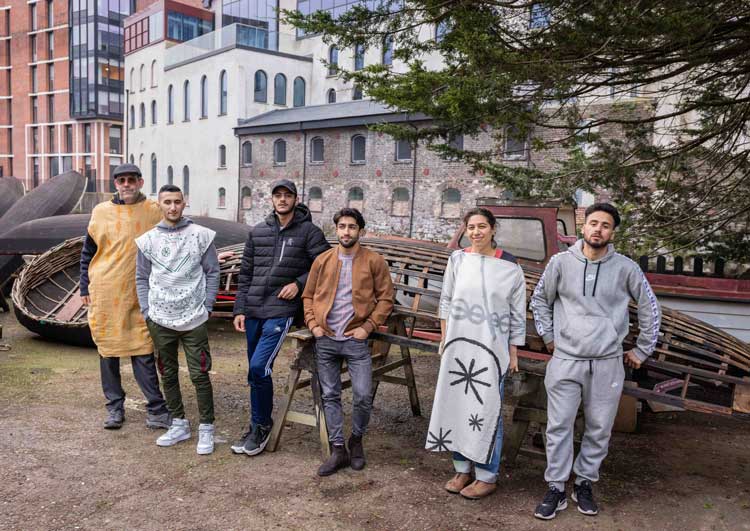
Ceyda Oskay (second from right) with musicians (from left): Rory, Hasibullah, Fouad, Hashmat and Ayman, at Meitheal Mara Teoranta boatbuilding yard in Cork. Photo courtesy John Beasley, Cork, 2022.
Janet McKenzie: You have come to Cork specifically for this residency. Can you tell me about your project?
Ceyda Oskay: I’m working with a group of improvisation musicians who are part of Music Generation, a project that was started by Bono. Cork Printmakers put me in touch with them when I told them I wanted to work with improvisational musicians who had experienced migration. I wanted to explore notions of uncertainty in both improvisational music and in migration by working with them. Rory McGovern and Joe Philpott led the musicians there, and it was a joy to work with them. Des Cullinane is the director at Cork City Learning Support Services.
JMcK: In Cork, there are a lot of refugees and a significant number of foreign students. Ireland was quick to offer asylum to Ukrainian refugees, especially compared with the UK, where the bureaucracy was complicated and unwelcoming at a government level. Considering the size of Ireland, a large number of people from Ukraine have been taken in.
CO: In Cork, there are a number of different venues, like shops that have all kinds of food from around the world, and the city has a cosmopolitan feel to it. A lot of refugees and migrants have been made welcome, as well as lots of foreign students. I’m working with them and I’m putting on a music performance with them [this event took place in November 2022], which is in the form of a video at Meitheal Mara Teoranta, the boat-builders on a dock just around the corner from here. There are half-finished boats and I’ve always been struck by the image of boats that are incomplete, because the bones of the structure create a double, liminal kind of space.
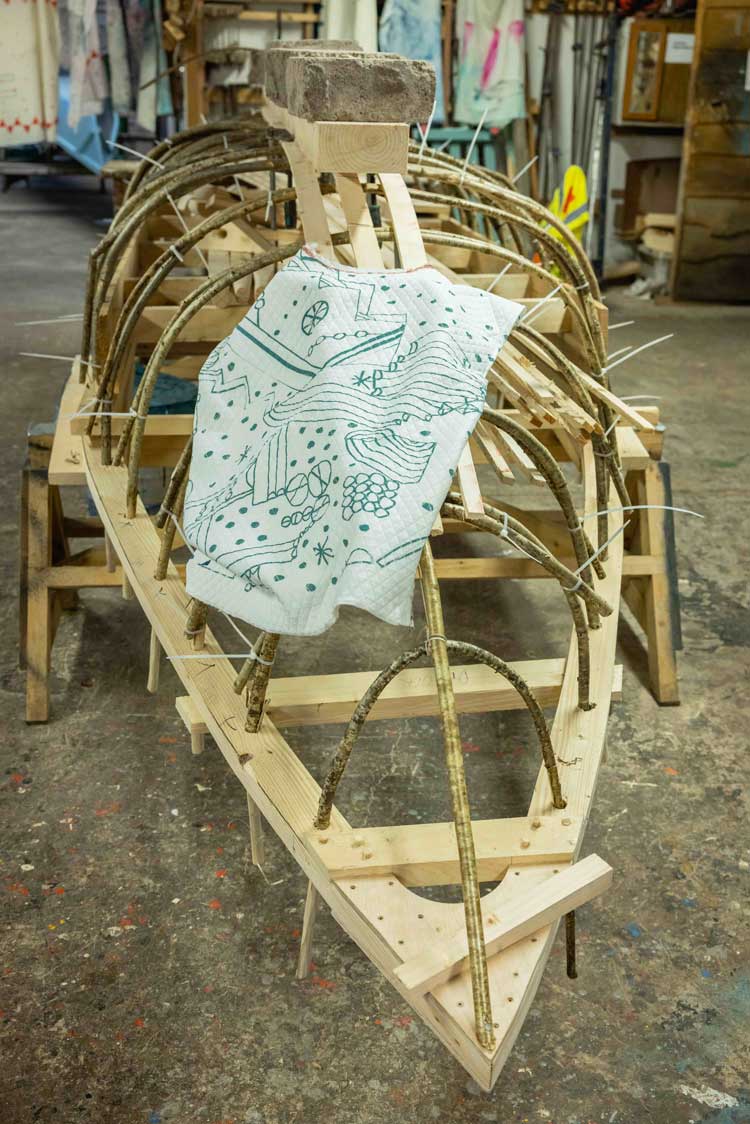
Printed shirt on a boat frame at Meitheal Mara Teoranta boatyard, 2022. Shirt created for In From the Margins, from Ceyda Oskay’s clothing brand, cc by co.
Photo courtesy John Beasley, Cork, 2022.
JMcK: Metaphorically, the boat is a very rich image in numerous cultures. And it refers to the journey of human life.
CO: It’s not a literal image to reference the refugee situation, but metaphorical. And with music, too, trying to convey something about the uncertainty of migration, as well as the maybe more enjoyable uncertainty of playing music that’s improvisational. And that relies on intuition and a different way of hearing or communicating with the other musicians.
JMcK: Yes. And music can be seen as an international language, not limited to one culture or one group.
CO: It’s a lovely connection, because some of the displaced students at the Cork City Learning Support Services are there to learn English. Some of those in the project were studying at university in their home countries but were forced to leave.
I grew up moving from one place to another, mainly between the Arab Middle East and Turkey. We were living in Kuwait at the time of the invasion by Saddam Hussein. Being Turkish, adds another layer. Historically, Turkey is a sort of a crossroads. A lot of people travelled through it and stay for a short time or more permanently, especially asylum-seekers wanting to go on to other places in Europe. It has a long history of being at an intersection – I mean, it borders seven different countries: Greece, Bulgaria, Syria, Iraq, Iran, Armenia and Georgia and it shares a maritime border with Russia. That makes for such a diverse mix, as well as being a post-Ottoman empire. And our own culture is kind of mixed with that as well. I used to work on migration issues for the UN and spent many years with the United Nations high commissioner for refugees, based in Ankara and Turkey, and in Kuwait for Iraq. Later working with other UN offices, I was based in south-eastern Turkey for Syria, and then in Istanbul for eastern Europe and Central Asia.
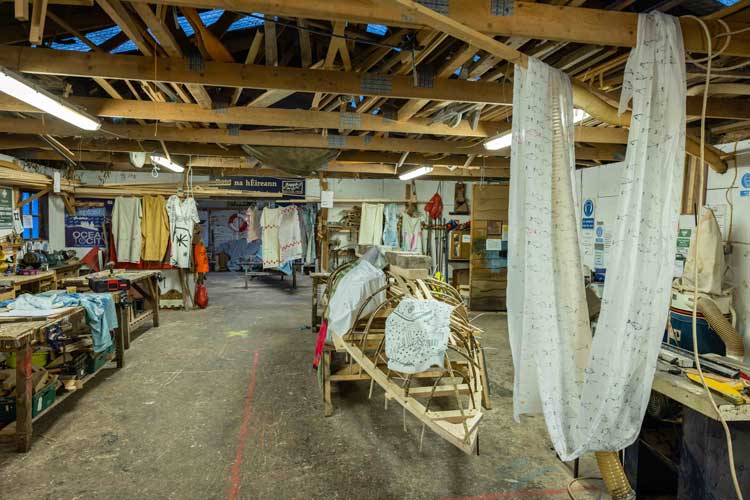
Ceyda Oskay: after the performance at the Meitheal Mara Teoranta boatyard. Photo courtesy John Beasley, Cork, 2022.
JMcK: That is an impressive career to have had – and to have given up to become an artist!
CO: I do think about going back to UN work and about doing some consultancies, but then each time, an art project comes along, and now I teach at a fashion institute as well. At the moment, I am making the costumes for the music performance here. I think my interest in costumes and textiles comes partly because I grew up in Kuwait and Saudi Arabia, where there was a lot of emphasis on fabric and clothing, in my own family in Turkey as well. But, I think, especially in Kuwait, becauses part of the culture there has been migratory, nomadic, in addition to the present situation of immigration from other countries in the world. Culturally, there is a big focus on clothing and textiles, which were historically light enough to be carried on journeys, rather than static art objects. Weavings, for example, are part of the tent walls. Because these textiles were unique to the climate of the desert, they were not mass produced to be used elsewhere, they stayed unique in their patterns. While symbols were repeated, no two weavings are identical, even by the same viewer. They are a mix of craft and art.
JMcK: What did you study at university?
CO: International studies in Chicago. I wrote my BA thesis about South Africa, based on the collections at the South African National Art Gallery, and its role in integration in South Africa, because it went from representing a certain South Africa to a more diverse society. I wrote about the visualisation of that process.
The current project started with designing costumes for the musical collaboration. I was thinking about a link between Turkey and Ireland. And I learned that during the Great Hunger, in 1847, Sultan Abdülmecid I sent three ships of grain to the port of Drogheda. The British navy attempted to block the ships. Drogheda has since incorporated the Ottoman flag into its city flag to commemorate the generous act.
When I left the UN, a lot of my work was about war, but it didn’t last long. And I then started to create situations that led to more socially engaged projects that were more about the present or the future and about people working together directly in that moment.
JMcK: Every generation has a different sense of its relationship to the external world and to politics and it is part of being an artist in the 21st century.
CO: The music collaboration attempts to bring these issues in to the present, and also to push assumptions and boundaries, including my becoming part of the group for a month – as a performative Cindy Sherman in an abstract manner – a process of performance and assimilation that many of us go through again and again. The designs that are hand-painted on to the fabric for the garments, as well as the printed ones, are all waiting to become animated. And I think that in certain artworks, where there’s an intention to understand or achieve an improvement in life, then you have got the sense of being poised. It could be an anxiety, but it’s a positive thing in the context of the project In From the Margins.
JMcK: Can you tell me about the myth that inspired the use of the fish image in your work?
CO: I like using the fish form, but in this context, I am referring to the Irish myth of the Salmon of Knowledge, which tells the story of a magic fish that held all the knowledge in the world. The poet Finegas who lived nearby was intent on catching it and eating it. A young warrior named Fionn had come to live with Finegas and during this time Finegas finally caught the fish.
When Fionn was cooking the fish, he burnt his finger and to soothe the burn he put his finger to his mouth. But when he touched his mouth, all the knowledge transferred to him. I like the fact that the myth was related to water and the salmon to migration.
JMcK: The fish is a universal symbol, as are birds that appear in your imagery. Looking at the fabric designs, I can see that as they become worn performative garments, they assume new forms, where movement creates texture and folding.
CO: As costumes, the images become more of a living entity, moving and going through journeys themselves as they are worn – as well as their own past present and future, as objects. Some of the designs are more geometric, and they are from my doodles. But people have compared them to tiles or to maps or different kinds of abstract symbols and things. That sometimes becomes enlarged and amplified, and an entire print on the clothes. And then with the fish sketch, I scaled it down and then I did a repeat, like schools of fish swimming.
• An exhibition of work from artists working with In From the Margins will take place at Edinburgh Printmakers in April 2023.
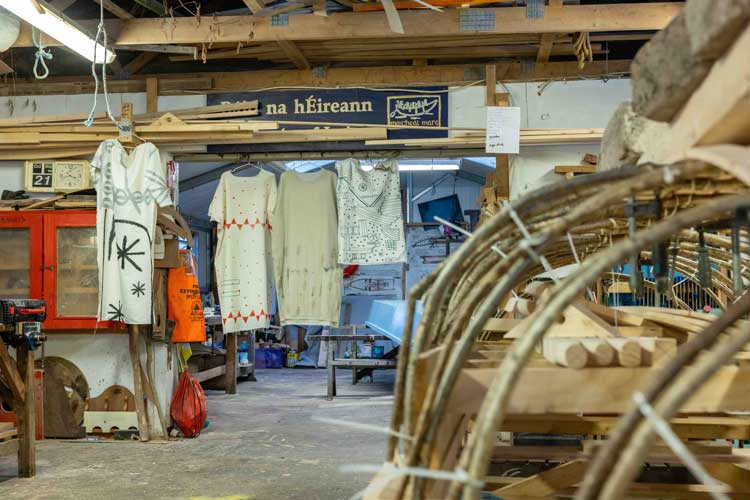
Garments from Ceyda Oskay’s clothing brand, cc by co, created for In From the Margins, hung in 2022 in the boatbuilding workshop Meitheal Mara Teoranta in Cork.
Photo courtesy John Beasley, Cork, 2022.
Click on the pictures below to enlarge